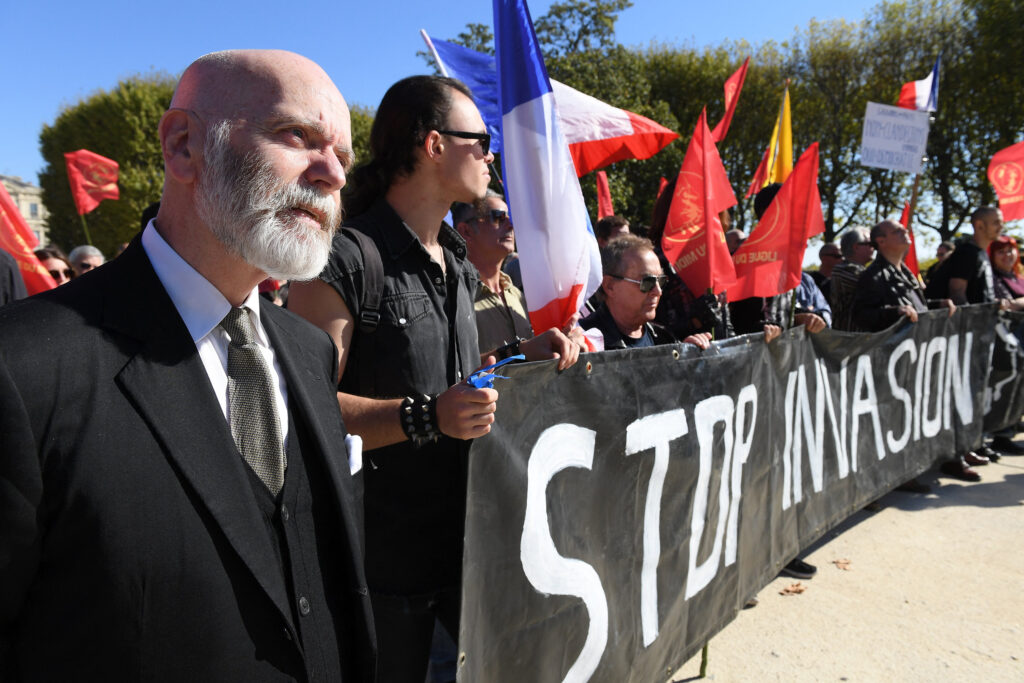Behind the knife
The intellectual roots of ecofascism

On April 2, 2024, a white Briton named Callum Parslow entered the restaurant of a countryside hotel called the Pear Tree Inn, walked up to a dark-skinned man he found eating there — someone completely unknown to him, evidently chosen entirely at random — and asked where he was from. When the diner answered that he was from east Africa, Parslow pulled out a knife he had ordered from America specifically for the occasion, and stabbed him repeatedly.
Parslow’s chosen victim, an asylum seeker from Eritrea named Nahom Hagos, was fortunate to survive the attack. In Parslow, what he’d brushed up against wasn’t simply garden-variety racist hatred, but a form of hatred equipped with an ideology — and still more, as the attack itself suggests, one increasingly inclined to express itself in lethal action. Consider the justification Parslow later attempted to post to his social-media accounts:
“I just did my duty to England…They will call me a terrorist, they will call me an extremist: I am neither. I am but a gardener tending to the great garden of England. I removed the weeds; I exterminated the harmful, invasive species.”
He goes on to blame “the evil enemies of nature and of England,” whom he identifies as “the Jews, the Marxists and the globalists.” White-supremacist violence has, of course, been a sadly familiar feature of our world since time out of mind, and there’s nothing even remotely novel about that specific list of designated enemies. But the ecological language in Parslow’s pompous little screed is notable, especially its conflation of nature and nation, and it speaks to a current of thought we desperately need to understand as it not merely increasingly drives events like this unprovoked assault, but inches ever closer to mainstream currency.
However vaingloriously, however absurdly, Parslow clearly believed that, in putting a knife into the first visible immigrant he came across that Tuesday, he was somehow “tending to the great garden of England.” Wherever did this misbegotten notion come from?
What Parslow was alluding to in his identification of the “evil enemies” ostensibly responsible for Nahom Hagos’s appearance in the Pear Tree Inn is a theory originally proposed by the French novelist and essayist Renaud Camus and now propagated to the masses by figures like the British petty criminal Stephen Yaxley-Lennon and the American media personality Tucker Carlson. It is called “the Great Replacement.”
As with many of history’s most dangerous ideas, Camus’s fabulation proceeds from a kernel of truth. Many societies of the Global North, including the United Kingdom, are currently undergoing a demographic transition and becoming more diverse in their ethnolinguistic composition. The previously unquestioned privileges and prerogatives of the majority population are being eroded in most of these societies, however slowly and inadequately. These are facts. What Camus proposes, however, is that this demographic transition and the accompanying erosion of privilege have been deliberately engineered by sinister elites — the “Jews, Marxists and globalists” of Parslow’s manifesto — with the aim of “replacing” the white native population with a majority-Muslim one presumed to be more pliable.
This is to be accomplished through a dual program: on the one hand allowing unrestricted immigration from Islamic lands of the global South, and on the other suppressing the birth rate of the native population. What immediately leaps out is how oddly and persistently prurient these ideas are. The specific measures purportedly deployed by the “replacist” elite in its effort to suppress the white-majority birth rate all have this quality to them: we are told that they include the expansion of access to abortion, the normalization of hardcore pornography, the celebration of homosexuality, and the promotion of gender identities beyond the traditional binary. (It is never made clear why these measures are only supposed to suppress native-born, white, Christian fertility and not fall equally across the entire population, but the obsessive focus on who is doing what with whom, and in what way, is nonetheless striking.)
And consider everything this master narrative wraps up, in one neat ideological package. People already suffering from the real consequences of living in late capitalism — among which we might list the shattering of communal life, the transformation of everything into a commodity, the elevation of exchange value over any other kind, the global flattening of culture, the shoddy deadening sameness of neoliberal space and the semantic desert of its cant — are assured that there is an identifiable party to blame for their agony. They are encouraged to exorcise their feelings of smallness and impotence by taking direct action. And if the shadowy agents of their misfortune should prove to be out of immediate reach, as compensation they are guided, in no uncertain terms, toward the more available bodies they may exert that action upon: the visible immigrants in their own communities. The proposition Renaud Camus offers to people like Callum Parslow has a familiar, devastatingly effective form: it’s the one scholars of advertising call “problem/solution.”
There is one further, especially salient quality about the way Great Replacement theory operates in our time of climate crisis: One of the things nativists permit themselves to believe when they adopt this narrative is that in moving to eliminate the alien Other, they’re doing ecological work. Consciously or otherwise, their plan to repair the atmosphere, revive the world of the time before, and restore the correct and ordained order of things consists in the physical elimination of the human beings identified as an “invasive species.”
An emergent ecological consciousness and fear of the dark Other have been intertwined in the Western imagination for a very long time and have been articulated in print at least since a book called The Passing of the Great Race, published in 1916. But it wasn’t until the 1980s that environmentalist sensibilities and a professed concern for the consequences of overpopulation fused in an overt hostility to immigration policy, and immigrants.
The widely beloved environmental activist and writer Edward Abbey, for example, notoriously described immigration to the United States from Latin America as “the mass influx of even more millions of hungry, ignorant, unskilled, and culturally-morally-genetically impoverished people” who “come to stay and stay to multiply.” Earth First! cofounder and “deep ecologist” Dave Foreman similarly characterized the United States as “an overflow pond for reckless overbreeding in Central America and Mexico (and for the Philippines and Africa and…),” arguing that “so long as we offer that overflow pond, there is less need to lower birth rates in those countries.” In the name of the wild places of the American land mass, and all the wild things living in them, both Abbey and Foreman called for the immediate imposition of harshly restrictive policies at the border. Foreman went further still, rejecting the practice of an environmentalism he identified with “the prevention and control of pollution for human health” in favor of a purified conservationism, dedicated to “the protection of wildlands and wildlife” for their own sake.
This latter, ostensibly nobler end required an absolute reduction in the numbers of humanity. In his book, Man Swarm: How Overpopulation is Killing the Wild World, Foreman argued that “we must bring our [global] population down to no more than two billion,” and if this stark reduction of the species required measures like cutting off food aid to famine-stricken regions of the Global South and “just let[ting] nature seek its own balance,” then so be it. Whether this sort of outright eliminationism is where the logic of “deep ecology” was leading all along isn’t clear, though the frankly racist language used by both Abbey and Foreman certainly suggests something telling about the shape of their desires. In any event, we can be sure that whoever it was who would need to go in order to make up the necessary numbers, it wasn’t going to be them or anyone who resembled them.
But to flense out and lay bare the actual origins of this doctrine in its present form, we need to cast our gaze back a decade earlier still. To a first approximation, the roots of contemporary Great Replacement theory, along with all its overtly genocidal offshoots, can be found in Jean Raspail’s notorious novel of 1972, The Camp of the Saints. In Raspail’s overwrought fantasy, the “numberless disinherited people of the South,” in taking flight from ecological catastrophe, swamp and overwhelm a European civilization long lost to decadence and declining vigor. Perhaps imagining himself as a lighter of beacons, some lone sentry sounding his clarion call from the ramparts, Raspail is writing to warn his native-born white readership of the true dimensions of the threat from the teeming South. He does so in language and imagery so cartoonishly repulsive that even describing it as “racist” is to considerably understate the case. This is a work of naked, visceral, horrified loathing for — and compulsive fascination with — the Other.
The Camp Of The Saints is the story of a flotilla of clapped-out freighters making its way slowly from Calcutta to the shores of France, bearing a reeking human cargo numbered in the hundreds of thousands. Led by a charismatic giant known only as the “turd eater,” this vile multitude aims to claim for itself everything denied to it throughout all the long age of empire — all the bounty and comfort and other good things of life tauntingly dangled before their eyes by the Europeans who invented them, but which they are constitutionally incapable of producing for themselves. The novel ends as of course it must: in the craven Easter morning capitulation of the French government before the “dismal fauna of the Third World battalions,” followed swiftly by the entire collapse of Euro-American civilization, as its last redoubts are swarmed by the filthy, fast-breeding invaders from the South. It’s a speedrun of the Great Replacement, a recapitulation of immemorial white fears with one sweaty thumb mashed on the fast-forward button. In depicting the encounter of North and South as a zero-sum clash of civilizations enacted at the sordid, intimate scale of bodies, The Camp Of The Saints steers its (presumptively white) reader toward only one possible conclusion: Do unto others before they can do unto you.
Raspail’s novel is so clownish and so over the top in its racism that there has never been any question of its suitability for mainstream publication. In the years since its appearance, however, there have been far more reasonable-seeming articulations of what is fundamentally the same set of ideas.
Of all contemporary attempts to lend preemptive violence in defense of white privilege the color of intellectual respectability, among the earliest and most enduringly effective was ecologist Garrett Hardin’s essay “Lifeboat Ethics: The Case Against Helping the Poor,” which appeared in the popular American magazine Psychology Today in September 1974. Hardin’s central conceit, which has since given its name to an entire genre of right-ecological thought, is to depict the wealthy nations of the Earth as overladen lifeboats, foundering on a sea of chaos: “In the ocean outside each lifeboat swim the poor of the world, who would like to get in, or at least to share some of the wealth. What should the lifeboat passengers do?”
Coolly pseudo-rational where Raspail is never anything less than ridiculous, Hardin’s message is much the same. His answer to resource depletion is naked: he opts for “population control the crude way.” It is more moral to allow billions of human beings to starve to death, rather than provide them with food aid, and all of this so their societies can learn to manage their affairs like the wealthy and responsible nations of the Global North.
This, in turn, is explicitly justified by the argument that it is necessary to preserve the natural environment so that the native-born European population may continue to enjoy its fruits of “clean beaches, unspoiled forests, and solitude.” Especially considering what is at stake in the topic under discussion, Hardin’s offhandedly patronizing tone is remarkable: In the aftermath of mass death, the poor nations “can learn from experience. They may mend their ways, and learn to budget for infrequent but certain emergencies.”
And when Hardin muses that the “freedom to breed is intolerable,” he leaves no doubt as to just whose breeding it is that weighs on his thoughts. “Lifeboat Ethics” is remarkably cavalier regarding the dispensability of the nonwhite Other, and remarkably precise as to which lives do and do not deserve to be mourned in their loss. Outside the minutes of the Wannsee Conference, the logic behind the engineering of deathworlds has rarely been made so shamelessly explicit:
“Every one of the 15 million new lives added to India’s population [annually] puts an additional burden on the environment, and increases the economic and social costs of crowding…[E]very Indian life saved through medical or nutritional assistance from abroad diminishes the quality of life for those who remain, and for subsequent generations.”
There it is, sitting on the page as plain as day: an explicit act of rhetorical magick transforming the newly born to the already dead. It is not the only thing clarified in the course of this brief essay. In less than 5,000 words, Hardin plainly states three things whose relevance will become increasingly clear as the climate crisis unfolds: that even after the horrors of the past century, public intellectuals in the North will not hesitate to reach for genocide as a policy when it serves their interests; that what we would now think of as weaponized food insecurity is the means of accomplishing that genocide; and that it is to be undertaken in defense of the ecosystem, so that favored populations may continue to enjoy its gifts into an indefinite, white future.
Hardin’s depiction of things is a curious echo of The Camp of the Saints, and it’s not unreasonable to wonder if there might have been a connection between the two. But of the two, Hardin’s writings are by far the more dangerous: Where Raspail is properly understood as a frank white supremacist and immediate forerunner of the contemporary extreme right, the rather astonishing fact is that in 2024, one can still utter Hardin’s name in respectable company. (Indeed, for those of us more than usually aware of what Hardin stood for, and what he intended for his life’s work to achieve, every casual invocation of his “tragedy of the commons” is acutely painful.) And what we are learning is that, as everyday experience increasingly becomes one of life-altering storms, wildfires, floods and droughts, there is no shortage of parties willing to take Hardin at his word and translate lifeboat politics into deadly action.
Among democracies, for the most part it is only in the United States and Brazil that climate denialism retains any particular purchase on the rightist imagination. Elsewhere, reactionary parties are generally pleased to present themselves as taking decisive action on what is, in most places on Earth, a matter of broad and shared public concern. (Not infrequently, indeed, they win support to the degree that they are seen to do so, as Marine Le Pen’s Rassemblement National has in France, Viktor Orbán’s Fidesz has in Hungary and Perussuomalaiset, the “Finns Party,” has in Finland.) In taking the “soil” in the usual blood-and-soil formulation slightly more seriously than has generally been the case in the history of fascism, these parties are merely the latest of a long line to have articulated a brown/green fusion.
Such movements forthrightly co-opt the language and the logic of environmentalist activism — for example, professing a concern for the preservation of “human biodiversity,” when what they’re talking about is the bluntly racist ascription of behavioral difference to genetic makeup. And this professed concern for human difference shades imperceptibly into the necessity to sort humanity out into ethnolinguistic homelands and thereafter maintain heavily policed borders between them. Amid the conditions and sensitivities of the present moment, it’s a canny move, lending a superficial gloss of concern for the natural world to an ideology that’s otherwise a nearly pure howl of racial resentment.
To be sure, many on the right wear their ecological consciousness lightly, deploying it primarily in the hope that it might afford a means of access to audiences that would otherwise be repelled by their extremism. But for others, the belief in nature as a pre-existing unity is entirely sincere. The tenets of such a belief were perfectly expressed in an April 2013 statement issued by the self-proclaimed “Green Wing” of one well-known fascist formation, the Greek Golden Dawn movement: “The leftists and the hippies tried to claim the ecologist movement as their own, but [our] love for nature is different than theirs: The environment is the cradle of our Race, it mirrors our culture and civilization, making it our duty to protect it.”
Depictions like these cleave a fatal line through the heart of the world. On this side of the line stands everyone who counts; on that side, the outside, are all the lives that have been rendered, precisely as in the notorious Nazi formulation, “unworthy of life,” neither to be furnished with care nor grieved at their end. To the degree that it is sincere, a belief in the Great Replacement is a way of giving oneself permission to discount all of the lives that one chooses not to protect: to write the value of those lives down to zero, and ultimately to turn away from whatever suffering they experience. Wherever parties like Fidesz or the Finns secure power, they move without demurral toward inscribing that turning away as national policy. And when the Other is already, unaccountably, inside the wire — a physical, bodily manifestation of the dark replacist conspiracy — some will take the fatal step further, just like Parslow did, and act in preemption of the threat they perceive.
This may well strike you as quite a lot of fuss to make over what is, after all, merely a body of rhetoric, or a leap beyond any conclusion justified by the available evidence. But we might want to remember that few acts of rhetorical production take place entirely in a vacuum. And this one certainly does not: On the contrary, it has a growing audience, whose members have been primed to interpret events in their daily lives as fulfillments of Camus’s prophecy, and act in defense of everything they perceive is in the process of being stolen from them.
Words inspire deeds and legitimate them retrospectively. This is how stochastic terrorism works. Beyond Callum Parslow’s assault on Nahom Hagos, acts of “lone wolf” violence in which the perpetrator explicitly invoked Great Replacement theory as a motivation include, as of this writing, the October 2018 murders at a synagogue in Pittsburgh, PA (11 victims); the March 2019 massacre of worshippers at two mosques in Christchurch, New Zealand (51 victims); an August 2019 rampage at a Walmart in El Paso, TX (23 victims); and the May 2022 slaughter of Black shoppers at a Buffalo, NY, supermarket (10 victims). And if there is anything we are sadly safe in saying about this list, it is that it will grow longer.
Writers like Camus, Abbey, Foreman, Raspail and Hardin didn’t train or equip or even directly encourage these shooters, of course, any more than the theory of dialectical materialism on its own produced the Gulag, or Mein Kampf the Final Solution. A long chain of material circumstances and enabling conditions had to come into being and lock into place before any of these things could happen. The doctrine alone is never sufficient to produce acts of murder. But it is a necessary first step: the foundation upon which the architecture of atrocity is constructed, piece by piece. The steady seep of Great Replacement doctrine through society, in both its undiluted and what we might call its diffusion forms, is how the move toward something previously regarded as unthinkable acquires its aura of inevitability. Indeed, the perceptible formation of consensus around the inevitability of such an act is no small part of what brings its conditions of possibility into being.
We should, of course, be wary of offering a totalizing, overly simplistic theory to account for any behavior as complex as far-right violence. None of this is meant to “explain” white grievance, or those analogous sentiments like Hindutva that prevail in regions of the world where the dominant population is not of European descent. But we do need to understand what happens when these preexisting currents intersect an authorizing body of rhetoric, a set of environmental triggers, and the enabling material conditions — for when they do, the results are unspeakable.
What seems clearer with every passing day is that too many of our own neighbors now cannot help but see in the bodies straggling onto the beach the “vanguard of an antiworld bent on coming in the flesh to knock, at long last, at the gates of abundance,” and in every overloaded raft and floundering trawler all of Raspail’s most absurd fears realized. And this is so because Hardin’s nasty little essay has done its work. It has delivered its memetic payload, and that payload continues to propagate, conditioning thought and expression even in those who have never heard of “lifeboat politics.” Even now, it remains the template that all too many bring with them to the interpretation of events.
Consider in this light the October 2022 comments of Josep Borrell Fontelles, then both High Representative of the EU for Foreign Affairs and Security Policy and Vice President of the EU Commission: “Europe is a garden… Most of the rest of the world is a jungle. And the jungle could invade the garden.” Borrell’s language is strikingly reminiscent of Purslow’s, but this isn’t a maladjusted loner with a Hitler tattoo speaking. This is one of Europe’s most distinguished representatives, and a lifelong member of the PSOE, the Spanish Socialist Workers’ Party — at least nominally, a man of the left. It would seem to be the case that Hardin’s ruthlessly zero-sum logic appeals to a great many, almost independently of whatever nominal political affiliations they might profess. It is not difficult to see where this road is leading. It isn’t simply harsh immigration measures, restrictive border policies or deathworlds in miniature, each one the scale of an overloaded raft or refrigerated trailer stuffed with corpses. It is preemptive elimination of the Other. Every reinscription of Great Replacement theory and every casual invocation of the supposed “tragedy of the commons” takes us one step closer to the moment of its realization.
I believe it is still possible to interrupt or short-circuit this process. If we want to do so, and therefore to circumvent the rise of an explicitly eliminationist ecofascism, the essential thing is to create lifeworlds, capacious ones, in which it is possible for all of us to experience purpose, power and a sense of our own capacity, even within the larger enclosing context of ecosystemic collapse. We must salvage the makings of a world girded with care for one another and develop a way of thinking about that care that invites rather than excludes, now while we still enjoy some measure of the time, space and means necessary for us to assemble them. We will all of us have to make our way together, and quite literally forge a modus vivendi, in whatever regions of the Earth remain capable of sustaining human society — but we can only do so if the ideology that motivates a man like Callum Parslow is prevented from poisoning our discourse more than it already has.
Adam Greenfield is a London-based writer and urbanist. His most recent book is Lifehouse: Taking Care of Ourselves in a World On Fire (Verso, 2024).


